road fuel prices in France, including new fuel labelling
Prices from French roadside and motorway service stations are higher than those at supermarkets.
From late July 2017, the then new Macron government created a very useful website showing the current fuel prices at service stations in each commune. These data change daily, using the price declarations the service stations have to make to the government for tax purposes. As such, this website is a very useful aid for finding the best prices as you journey through the départements of France.
Le prix des carburants [app. is downloadable from app stores. |
average fuel prices per litre
[Prices in white seen
on the road, last price/date in grey,
prices in mauve from Prix des carburants en France, site gouvernemental] |
on 26 September 2023
on 8 August 2023 |
sp
98/E5 |
sp
95-E10 |
gazole/B7 |
| autoroute/motorway [1] |
2.220 €
2.180 € |
2.120 €
2.080 € |
2.070 €
1.980€ |
roadside
(Total) |
1.2029 €
1.924€ |
1.939 €
1.864 € |
1.969 €
1.811 € |
| supermarché |
1.997 €
1.923€ |
1.879 €
1.865 € |
1.899 €
1.779 € |
UK supermarket,
[AA figures for August 2023] |
super/E5
1.771 € / £1.539
1.745 € / £1.500 |
95 octane/E10
1.679 € / £1.456 1.639 €/ £1.413 |
diesel/B7
1.702 € / £1.475
1.663 € / £1.45 |
[UK prices calculated at
£1 = 1.1500655 € £1 = 1.16302 €] |
Note that currently (September, October 2023), British fuel prices are better than those in France. So fill your tank to the top BEFORE you make the Channel crossing to France.

Note that the differential between
supermarket and motorway fuel price varies over time.
The cost of diesel [gazole] is higher at French roadside service stations, and even higher at motorway
ones. You can currently save approximately
15-20% by buying from supermarkets, relative to motorway fuel stations, or about a penny a mile, by buying from supermarkets.[2] [4]
But if you drive on the tolled motorways, the tolls
will cost you over 10 centimes a mile [3],
approximately two-thirds the fuel cost, but see
the update
on autoroute tolls, January 2011.
Because of the recent fuel price rises, motorway
tolls are now a smaller proportion of the overall
cost of motorway driving, though obviously, the
monetary cost of going by motorway is always higher
than travelling by main roads.
Thus, driving on the tolled French motorways is
somewhat a luxury. Some motorways are not tolled,
especially around large cities and in northern France.
However, driving long distances through France
off-motorway can be very tiring and tiresome - winding
through village after village, and cramped and crowded
towns. There are long stretches where overtaking
is difficult and lumbering lorries are routine.
It can add much time to your journey, while not
improving the nerves or the mood. To add to the
fun, given the French standard
of signing, in the larger towns without a bypass
it is also all too easy to become lost, especially
at night. While you will pay considerably more driving on motorways, with the steady speeds and more direct routes you may also have a 10-20% saving on fuel costs.
Historic price information is held at end
note 10 below for reference purposes.

august 2023 : rising fuel prices - why prices at the pump soar again in August
In one month, fuel prices have increased, and returned to their summer 2022 level. Very bad news for motorists on the road to their holiday destinations during the time of crossovers.
While for three weeks, fuel prices have started to rise again, this increase has been confirmed officially in data published 7th August by the Ministry of Ecological Transition. Thus last week, prices for unleaded 95 increased by +2.8 euro cents per litre to stand at 1.89 euro per litre. Diesel follows the same trend with an increase of +6.7 euro cents per litre, with a price of 1.8 euro per litre. Since the beginning of July, the SP95 has increased by more than 6%, the surge is even more at 8% for diesel in just 4 weeks.
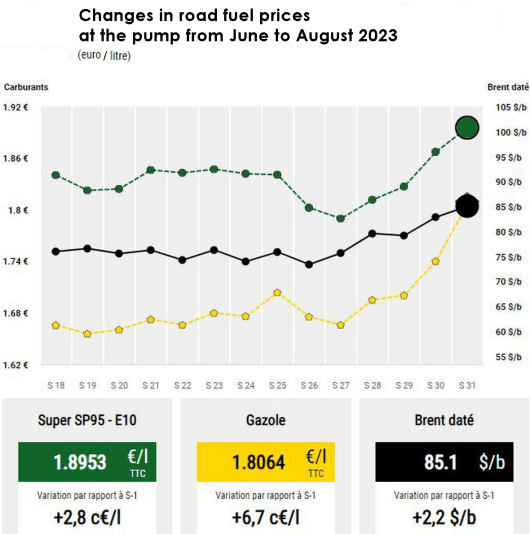
Road fuel prices at the pump on 7 August 2023
Image credit :
GOVERNMENT
Note: S19 etc refers to the week number (semaine in French),
so S18 is 1st to 7th May, while S31 is 31st July to 5th August.
Prices supported by producing countries
Up until now, these significant increases in fuel prices had been trending towards lower summer prices than those in 2022. But the situation has changed this week with the diesel price returning to the price of last summer, and the unleaded price exceeding its level of last summer. However, we are still a long way from the records of early 2022, when the context of the war in Ukraine, combined with inflation, had led to a surge in the market.
Two reasons may explain this summer's price rise. The price of oil is on the rise with a barrel of Brent selling for around 85 dollars, whereas the price was only 75 dollars in May and June 2023. It should also be remembered that the countries which export oil have made the choice to reduce their production until the end of 2024, a choice that leads to sustained prices for them and higher prices for their customers.
Finally, France does not produce diesel, she imports it, mostly from the USA and so is very dependant on foreign situations, actions and whims.
crossover (in French, chassé-croisé, this word's plural being chassés-croisés) :
Traditionally, the French have set dates for arriving at and leaving their holiday destinations. Just as the French will leave the beach at 6pm in order to be at home for dinner at 7pm, they travel on set dates. The current major holiday crossover is the last weekend of July/first weekend in August. This leads to traffic jams of nearly 1,000 km on the favoured motorways such as the A10 and A63.

fossil fuel taxation
Taxing fossil fuels continues. Previously, taxes were increasing on diesel and falling on petrol. From 2018, they increase on both, but faster on diesel than on petrol, to align the two fuels' prices, it having been decreed that all diesel engines are more polluting than petrol ones. According to the calculations of the French Union of Petroleum Industries (UFIP), taxes on diesel could increase by 31 cents per litre by 2022, if the progress in the new finance law is fully implemented. For petrol, the increase will be 15 cents.
This nice little earner punishes the many diesel vehicle drivers just not able to just buy a more expensive but apparently ecological, electric or hybrid car. The scrappage premiums are not realistic for the less well off, often living outside large towns, so dependant on individual transport.
Since July 2018, when the speed limit on most secondary roads was reduced from 90 kph to 80 kph, the illusion of reducing pollution has been amplified. Cars are designed to have a cruising speed range where the car hums along, comfortable at the optimal rpm range and so giving the car's best fuel consumption. This cruising speed range was designed so the lower end of its range was near to the secondary road speed maximum - 90 kph. And what happens when the car is forced to drive at a lower speed? Fuel consumption increases, the car cannot produce sufficient heat to enable the catalytic converter, that converts carbon monoxide and other hydrocarbons into carbon dioxide and water, to work effectively. More pollution.
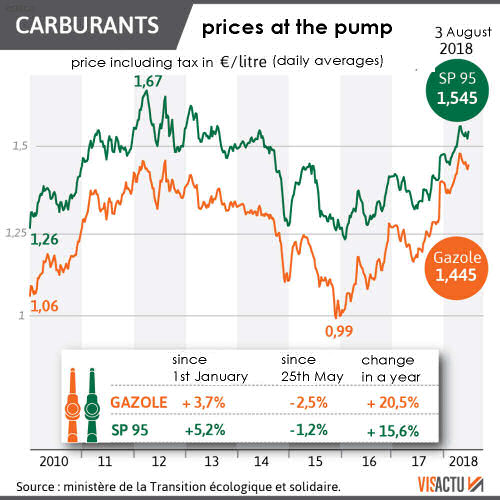
French fuel price changes. Image credit: VISACTU
|
Journey
planning
Also
see pre-route
planning with GoogleMaps.
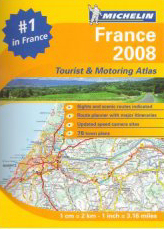 Use
a large road atlas, such as the one published
by Michelin, for your preliminary trip planning.
Once you have determined the general route, then
use on-line planners which
can give detailed information on distances, toll
and fuel costs, and the location of speed cameras. Use
a large road atlas, such as the one published
by Michelin, for your preliminary trip planning.
Once you have determined the general route, then
use on-line planners which
can give detailed information on distances, toll
and fuel costs, and the location of speed cameras.
For
more local maps, use Institut Geographique
National (IGN) Blue Series maps. IGN is the French equivalent
of the Ordinance Survey in the United Kingdom. Blue Series maps
are 1:25,000 or 1 cm to 250 metres. The maps can be bought in
a local Presse/newspaper shop or supermarket. However, this is
a little haphazard, especially for the high-scale versions, as
these places usually only hold maps local to them.

Mappy is an excellent, if slightly clumsy, on-line road planner. It
also gives you the option of checking your toll costs for using
motorways.

Map24 is another online route-planning site, with several Java-powered
interactive facilities. Although in French for the map of France,
Map24 is mostly intuitive to use and can even be fun. It is possible
to look at the map related to your chosen itinerary in various
degrees of three dimensions [VUE 3-D], as if low-flying over the
land. The amount of zoom can (almost too) easily be changed [ZOOM];
while when at least one intermediate way-point is specified, you
can select which part of the journey to study [NAVIGATION].
Remember to prepare
your car to be both legal and safe in France.
radar
speed cameras and more
| Advance warning |
update 11.10.18
Level crossings can be trickier than you think - another cash cow
Not only does a driver have to make sure their car does not stall, or a cyclist that their wheels don't get stuck, there is a further traffic trap to be found at some level crossings (passage à niveau).
In 2017, there were 15,405 level crossings on the national railway network - 0.4% were across national roads, 31.4% across departmental roads and 68.2% across municipal roads. Bearing these numbers in mind, there is a grand total of 80 level crossing cameras in France, that is one for every 192 crossings. A rare creature then, that is installed on what is called "priority crossings".
The camera is very similar to those used with traffic (red) lights. The essential difference is the level crossing red flashing lights are synced to alternate with the camera flashes so each snapshot can highlight when the signal turned on.
There is a safety delay, after which drivers who go across the crossing are flashed and fined (90€, and 4 points deducted for three years for holders of a French driving licence).
The first flash occurs when a vehicle starts to cross the line,
and a second flash follows when the vehicle has continued their course at the crossing, whether on the railway line or when crossing the barrier line. |
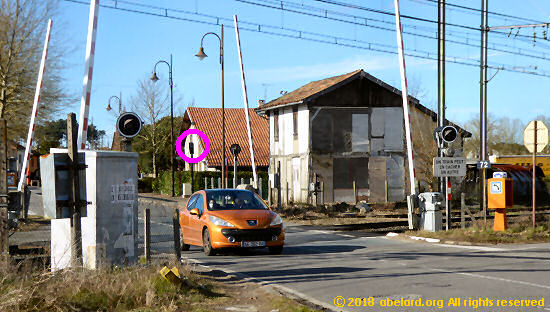
View showing a railway level crossing camera (circled in pink) |
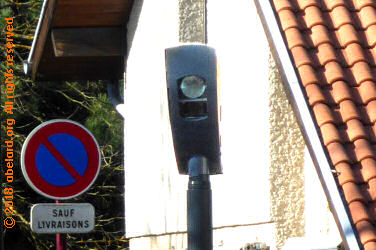
Railway crossing camera - close-up |
safety delay and reaction times
In order to allow users to stop safely to comply with the flashing signalling, there is a safety delay, similar to the amber light for traffic lights, is set on the equipment. This delay is 3 seconds in built-up areas and 5 seconds outside built-up areas. It is only after this time that illegal crossings will trigger the radar flash.
Note that for an average driver, from reacting to starting braking is 2.3 seconds. Some drivers take three seconds even to react, while a common reaction time of 1.5 seconds is often used in accident reconstructions. At least that time again is needed for the car to stop under braking. When driving at 50 kph (the maximum legal speed in towns), the reaction distance is just over 7.7 m or two car lengths, while the braking distance is over 15 m or four car lengths, the total average stopping distance being 23 m or 6 car lengths. This is not good when you are being followed by the typical French tailgater. Clearly, someone is more interested in money than common sense.
update 13.09.15
Front and back-flashing cameras
From Monday 14th September 2015, a new generation of speed cameras is coming into full service, with fines being issued to vehicles flashed.
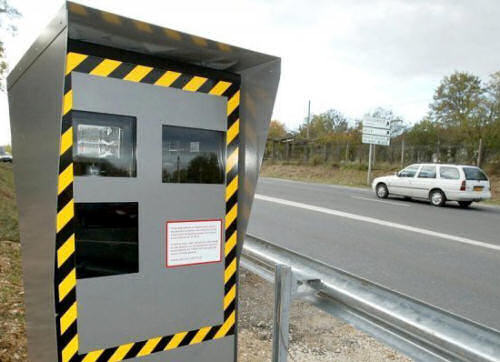 |
The camera must be positioned to one side of a road, at car level.
The three windows are larger.
Top left box - the flash, top right - the two cameras,
bottom left - the radar. |
 |
| Looking into the top right box, there are two cameras. |
The new cameras photograph both front and rear number plates. One version of the cameras photographs one car two times - as it approaches the camera and then again as it goes past and away (there is little further information available on these cameras). In the other option, the cameras photo the number plates of approaching cars in one lane, as well as those of cars going away on the further lane of a two-lane road.
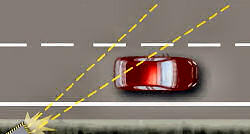 |
 |
| Camera flashes in one direction |
Same camera flashing for other direction. |
Regarding the first type of two-direction camera, the justification for photographing a car's registration twice is that 38% of photographs are legible, so this will double the chances of having a usable photo. It also means that the authorities can have a photo of the driver's face, which could help in cases when the car's legal owner was not the offending driver.
For the cameras that will photo cars on either lane of a two-lane road, it doubles the number of possible finable victims.
These cameras can only be mounted at one side of a road, at ground level. They do not function on gantries, nor in the centre of a dual carriageway road or motorway, not on a pole (like traffic light camera installations).
Kindly, "information panels are systematically installed" in each direction on the roads controlled by such equipment. And they are different to the current warning information panels. So when you see a new-type sign, you will look at both road sides to spot the camera.
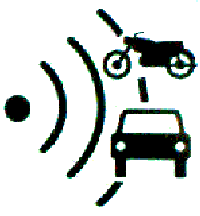 |
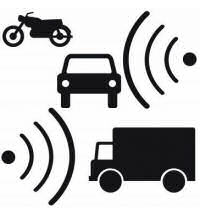 |
| One-direction speed camera sign |
Two-direction speed camera sign |
To begin with, the new two-direction cameras will be operating in 20 departments:
| Ain 9 |
Charente-Maritime 6 |
Hérault 3 |
Morbihan 7 |
Seine-Maritime 1 |
| Ardèche 5 |
Gard 7 |
Ille-et-Vilaine 6 |
Oise 12 |
Seine-et-Marne 4 |
| Bouches-du-Rhône 2 |
Haute-Garonne 7 |
Isère 7 |
Pas-de-Calais 3 |
Var 2 |
| Charente-Maritime 6 |
Gironde 8 |
Loire-Atlantique 8 |
Haute-Savoie 2 |
Vendée 12 |
In all, 111 cameras will being put into service now. This will increase to 200 by the end of 2015, and a further 500 is expected in 2016.
Many of the cameras are existing cameras that are having their software up-graded. As a result, the cost of the new system is reported to be 'only' 15,000 €.
france's speed camera cash cow
These cameras are being introduced now because the number of deaths on the roads is increasing again. However, only a quarter of fatal road accidents are caused by "excess speed", so these cameras appear to be more jackpot-paying slot machines (machines à sous) than accident-prevention devices. A French driving magazine has done some research, and found that 52% of speed cameras are not put in accident-prone zones. Why? Well, they do not make as much money. Cameras in accident-prone zones only flash 4,774 times in a year, while those in non-accident prone zones flash 12,000 times.
There are over 9 million automatic road cameras operating in France. When a vehicle is flashed, the traffic control computer systems have to co-ordinate with other data systems holding driver's and vehicle details in order to be able to fine and deduct points. According to a government report, 46% of offenders have no points deducted. If a person is driving a company car, the company most often pays the fine. There is a 12% likelihood that later the driver will be billed. Lastly, a good percentage of cases fail for 'technical' reasons.
Mind you, it's still a good thing to drive at a moderate speed, both for your nerves and for helping to minimise carbon dioxide emissions!
update 09.04.12
From today, all radar alerters and GPS systems,
like TomTom, that can alert the user to an approaching
speed camera, must have been updated to indicate
“Danger Zones”, rather than individual
cameras. The fine for using such a machine that
has not been updated is 1,500 € and the loss
of 6 points from your driving licence.
A “Danger Zone”, and its warning on
alerters and GPS, may start 2 kilometres before
there is any camera. Their length may be 300 metres,
2 km, or 4 km. The ‘danger zones’ may
be
- where there is a fixed radar,
- where there are particular dangers - a
dangerous bend, level crossing, traffic jams, road construction,
- where there have been several accidents before.
Until your GPS is up to date, disable the radar
camera detection facility. Then you can update your
GPS software later. If you are stopped by the police
or gendarmes, you must be able to present a certificate
that you machine has been updated, otherwise it
will be considered to be a radar detector and you
will be liable to that 1,500 € fine and 6-point
removal.
For
information concerning TomTom [English translation
of French TomTom web page].
For Garmin users, “on their website, customers
are encouraged to update their GPS for free”.
- As at 5 April 2012, there are
- 2765 danger zones with cameras,
15742 other danger zones
239 very accident-prone zones.
- But ‘danger zones’ are being chosen
by the Préfet of individual departments
and so can be pretty arbitrary. It is said that
they are increasing by 50 or more a month.
update 23.05.11
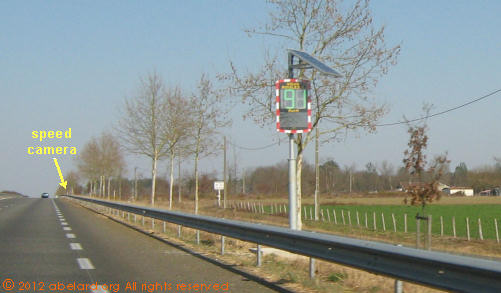
Speed indicator powered by
a photo-voltaic panel.
The speed indicated is very unreliable. In this
case, the speed being driven was about 75 kph.
Note that sometimes there is a speed camera not
long after the speed sign. Heaven knows whether
speed cameras are just as unreliable.
As well as these immediate speed detectors and cameras, there are also being installed measured-distance speed radar systems that flash up a driver's car registration number and the words TROP VITE! (too fast). So far, these gantry signs are operated by the motorway concessionaires, for "the drivers' education". It is expected, later in 2016, that government-controlled distance/time speed detectors will start to be introduced, with associated fining capabilities. It is unclear whether these speed detectors will inform drivers that their speed has been recorded. It's all part of driver intimidation.
May 2011
proposed fierce hardening of driving strictures
in France
It is being announced in French
newspapers, by September 2011, many new rules
proposed to penalise bad drivers. These new strictures,
no doubt, would help Nicholas Sarkozy in the run
up to the next Presidential election in 2012, while
much increased fines would help the French Treasury,
which like so many others is suffering in the current
financial malaise. A greater constraint on speeding
will also control fuel consumption.
- Signs forewarning of radar
cameras to be removed from the roadside, whether
for fixed or mobile cameras.
Also, by the end of 2012, a further 1,000 radars
are to be deployed, including 3rd-generation mobile
radars operated from cars that are travelling
amongst the traffic on the road.
- Gadgets warning of radar locations to be banned,
such as those made by Coyote, Wikango or Inforad,
although it is unclear how this will apply to
GPS that also give radar alerts.
- The government no longer to publish maps of
camera locations.
- Fines for speeds in excess of 50 kph above the
speed limit to incur a heavy fine (3750€),
a possible prison sentence and a loss of 6 points.
- Using mobile phones to be illegal while driving,
though hands-free kits will still be allowed.
- Stopping on the hard shoulder (the bande
d’urgence) now forbidden, attracting
a 135€ fine.
And don’t forget that wearing a fluorescent
waistcoat is now mandatory if you are on the roadside
outside your car. |
During 2006, the frequent contradictory, badly placed
road signs have even come to the notice of the French
TV news and the government. Now it is official, you can
expect to see consecutively speed signs of 70kph, 90kph,
50kph within a few hundred metres/yards of each other.
In contrast, French speed cameras are well forewarned
-
all changed, see
above.
Although we had been informed that the large prominent signs (below) would be removed progressively, this did not happen, so drivers should still keep a look out on seeing such a sign.
Although the location of each speed camera is no longer
identified by the French government on their web sites/maps, information can be. If you
generate an itinerary using Mappy,
it will locate (approximately) where there are any speed
cameras on your route.
Also, various motorist groups do provide them, usually
by region. Here is one such fixed radar/camera web site, which is being kept up
to date. [For other similar pages, try searching on “radar
routes france carte”]
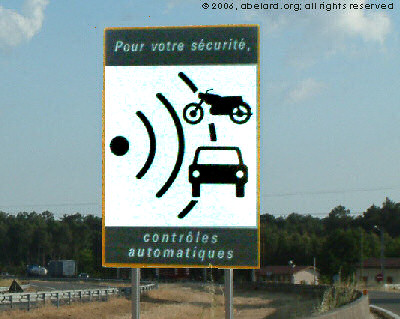
French road sign warning of a speed
camera ahead, now being withdrawn
However, although the warning sign is prominent,
the camera that follows is often placed discretely - under a bridge,
behind a road barrier, near a roadside planting. Also be aware
that French fixed cameras are not set on high supports as in the
UK, but are attached to a short support near the ground. There
is no reason in France to receive a speeding ticket from a fixed
camera, the signs like that photographed above are very prominent
and usually several hundred yards before the camera - see a sign
and make damn sure your speed is comfortably below the local speed
limit. You can even take pleasure in watching the cars rushing
past who are then flashed by the camera.
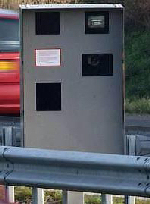 
French fixed radar speed cameras
left: photographs front
of vehicle; right:
photographs rear of vehicle
As well as the 1,000 fixed cameras on French roads, installed
since October 2003, there are also many mobile cameras
used by gendarmes. These may be set up at the roadside,
or looking out from the back of a police estate car. These
cameras should also be signed by a smaller, mobile warning
sign. Remember les flics are out to meet targets and to make money. Therefore, they may
‘forget’ to put out the sign.
French speed cameras send two photos and
accompanying data to a central processing point that, after assessment
that the driver was speeding, automatically sends out the paperwork
demanding the fine.
Fines are on sliding scales, depending
how much above the local speed limit the car was going. Be aware
also, that the fines are accompanied by a deduction of one or
more points from the driving licence, again on a sliding scale.
If
you receive such a demand, it has to be paid first (with the amount
doubling if there is delay) and any dispute can be made later.
However,
as a foreign visitor, you may well escape paying a fine, unless
you are caught by a roadside gendarme who demands an immediate
fine, or unless your car is registered in another European Union
country that has a bilateral agreement.
| French
speed limits |
when dry |
when
wet/other adverse conditions |
| Motorway |
130
km/h / 81mph |
110 km/h / 68mph |
| Dual carriageway |
110 km/h
/ 68mph |
100 km/h / 62mph |
| Open
roads |
90 km/h / 55mph |
80
km/h / 49mph |
| Town/villages |
50
km/h / 31mph |
50 km/h / 31mph |
- For town speed limits, the delimiter is the town
name plaque. On leaving the town there is another plaque with a black
diagonal line through the name. This marks the return to the open road
speed limit.
- In some villages, the speed limit goes right
down to 30 km/h, or even 20 km/h.
Euroland is gradually moving to reciprocal recognition
and shared data record storage of car registration. The
first countries that are moving towards such arrangements
are Germany, Holland, Spain. This situation will be complete
when the proposed European driving licence is in place.
April 2010: Permission has
been given for a further 3,000 surveillance cameras to
be installed in towns. The French police are using them
to watch for ‘bad’ actions by drivers, in
particular stopping or parking in illegal locations. As
towns become more crowded with traffic and parking is
often reduced to provide more pedestrianised areas, finding
somewhere to stop is becoming more irksome. Note that
fines can be 2000€ or more.
updated : pollution discs, the French ULEZ that started in 2017
 From the beginning of 2017, a new requirement rolled out to reduce air pollution caused by cars - the older ones and, particularly, those with diesel engines. Drivers must display Crit'Air stickers to show how much the car pollutes, the different colours on the stickers indicating the level of pollution (the most polluting cars have no sticker). Although this requirement has been voluntary, Crit'Air stickers are now mandatory in 12 cities with considerable pollution problems. The cities include From the beginning of 2017, a new requirement rolled out to reduce air pollution caused by cars - the older ones and, particularly, those with diesel engines. Drivers must display Crit'Air stickers to show how much the car pollutes, the different colours on the stickers indicating the level of pollution (the most polluting cars have no sticker). Although this requirement has been voluntary, Crit'Air stickers are now mandatory in 12 cities with considerable pollution problems. The cities include
There are also Restricted Areas (ZCRs) that include
Annecy, Chambery, Arve Valley, Côte d'Or/Dijon, Cruqe/Guéret, Deux Sèvres/Niort,
Drôme/Valence, Eure-et-Loire/Chartres, Gers/Auch, Haut-Savoie/Annecy, Isère/Grenoble, Loiret/Orléans, Maine-et-Loire, Puy-de-Dome/Clermont-Ferrand, Pyrénées-Atlantiques, Rennes, Savoie/Chambery, Vendée/La Rouche-sur-Yon, Vienne/Poitiers.
These zones can be activated temporarily as necessary, depending on the air pollution levels.
Air pollution, in particular from fine particulates and nitrogen oxide, is blamed for 2,500 deaths a year in Paris and 5,500 across France, higher numbers are also quoted.
The Crit'Air stickers, costing 3.11€ plus postage (total: 3.72€) are available from a government website (language selection at yop right of the page).
The application is spread over several pages, requiring full details of the vehicle's registration and a copy of the up-to-date registration certificate. The certificate has to be uploaded as a .pdf, .png or .jpeg format file, less than 400kB in size.
Note that after ordering, the sticker can take 6 weeks to arrive in the UK. However, French officials say that showing a printed copy of the email confirming the purchase of a sticker will be sufficient to show to police if the car is stopped.
The different categories are divided into petrol [essence] and diesel cars, and then when the car was first immatriculated (given an number plate).
Fines start at 68€ for light passenger vehicles, witht the fine increasing to 135€ if not paid within 45 days. Remember that you can and will be chased for payment in the UK.
Paris
"Paris is entering a new phase in its pollution control plan: from 15 January 2017, it will become the first Restricted Area (ZCR) in France. Vehicles circulating in Paris must be equipped with an air quality certificate, "Crit'Air", established by the Ministry of Ecology and Sustainable Development, that is to say a sticker indicating their Level of pollution.
—
"All vehicles are concerned without exception including those of disabled people and foreign vehicles."
All cars, vans, motorbikes and lorries entering Paris proper, the periphérique (the major ring road around Paris) and the Bois not being concerned, between 8.00 and 20.00 Monday to Friday, must have a Crit'Air sticker. If not, the driver is liable to be fined up to €68 for cars and €135 for lorries. There is no exception for foreign cars, even if just passing through Paris on the way to somewhere else.
This in addition to lorries, coaches and buses registered before1st October 2001,
petrol and diesel cars registered before 31st December 1996, and motor bikes and similarly engined vehicles registered before 31st May 2000 being banned all together.
As of 1 July 2017, the traffic ban will apply to diesel and light commercial vehicles with a Euro 2 sticker (put into service before 1 January 2001 - no new prohibition for petrol vehicles before that date) and heavy goods vehicles Euros 3 sticker (registered before 1 October 2006).
car maintenance - another government cash cow
Make sure that your car is in a good state when you come to France; From May 2018, the French M.O.T. is becoming much more strict as the result of an EUSSR edict. Although, foreign cars do not have to submit to a French M.O.T., gendarmes can be expected, when stopping foreign cars, to take advantage of the new regulations to help reach their targets for collecting fines.
end notes
- This
website (in French, but pretty intuitive to use) provides comparative fuel prices for each department,
or towns within a department, as well as price on each
motorway [autoroute]. It also indicates the price movements.
- Based on approximately 45 miles
per gallon, or 10 miles per litre.
- Breakdown of vehicle fuel prices after 1 January, 2015 (translated from diagram at francebleu.fr).
- Motorway tolls are often
being raised, amounting to roughly an additional 50%
in recent years. Because tolls cost nearly as much as
the fuel you will use on the motorway section of your
journey, your travel expenditure on motorways can be
almost as much as double the amount you paid at the
pump. Note that increases in fuel prices are now (2011)
running ahead of toll
price increases, so tolls will not be such a large
proportion of autoroute driving costs, though those
have increased widely during 2010-2011.
| Distance |
Fuel
cost |
Tolls |
| Current examples: |
| 275 miles |
44€ |
28.40€ |
| 122 miles |
20€ |
16.60€ |
[Based on supermarket diesel prices
during May 2008,
and average fuel consumption of 9 miles/litre,
approx. 41 miles/UK gal.] |
| Conversion
table |
imperial [UK] gallon |
US gallon |
litre |
imperial (UK) gallon |
1 |
1.2 |
4.546 |
| US gallon |
0.83 |
1 |
3.785 |
| litre |
0.22 |
0.26 |
1 |
- Remember, the difference will change according to the current
exchange rate.
- Getting lost is all too easy! This
is fairly frequent in France because French authorities
often seem to be allergic to upward-pointing arrows
for straight ahead (mustn't point - it's
rude, and you are pointing to God.
Or is it Descartian logic? Going up is impossible!)
- Directional road signs in France
are not set out to the standard of, say, British ones.
There is a real preference for putting road signs ...
- facing the opposite direction to the way you
are going (so, for instance, two circuits round roundabouts are
necessary)
- or after whatever is being signed (so
retracing is necessary),
- or hiding behind trees etc
- without including the road number
- using the name for the most obscure little village
instead of the one for the nearest big town
- During a French driving lesson, a yak was told to slow down to a virtual halt at every side road on the right that did not have a white painted line across it (the indication that drivers on the side road must stop before moving onto the more important road). Having slowed down, the yak had to look right, up the side road, to make sure that there was no car there about to require to be let out before the yak could advance.
- Here is a page with links
to maps of automatic radar positions in France generally,
and in the Paris region, together with a verbal list
of the positions, and more are being placed all the
time. There is also a FAQ (in French).
Mappy,
the online route calculator, as well as giving the motorway
toll charges, shows fixed radar camera positions on
the calculated itineraries. There are also hand-held
and vehicle-mounted versions in use, which the government
map and Mappy cannot show. The government are also introducing
technology to nab you for travelling too close (less
than 2 seconds gap).
Evolution of diesel
[gazole] prices at
supermarkets in France since 2001 |
| Jul. 2001 |
0.755€/l |
Jul. 2005 |
1.02€/l |
| Jan. 2002 |
0.70€/l |
Jan. 2006 |
0.999€/l |
| Jul. 2002 |
0.739€/l |
Jul. 2006 |
1.09€/l |
| Jan 2003 |
.0789€/l |
Jan. 2007 |
1.00€/l |
Jul. 2003 |
0.72€/l |
Jul. 2007 |
1.058€/l |
| Jan. 2004 |
0.78€/l |
Jan. 2008 |
1.17€/l |
| Jul. 2004 |
0.84€/l |
early May 2008 |
1.295€/l |
| Jan. 2005 |
0.87€/l |
late May 2008 |
1.428€/l |
| |
|
|
|
| Apr. 2010 |
1.136€ |
Aug.2011 |
1.274 € |
- Historic
information and figures for reference:
Petrol is, approximately, the same price as in the UK,
but diesel is, approximately, 25% cheaper. Well, it
is from the supermarkets.[8]
Buying fuel from supermarkets is approximately 15-20%
cheaper than on the motorways.[1] You will save, perhaps, the equivalent of up to 1p
per mile if you use supermarket petrol, and with diesel
you can save most of 3p per mile compared to the UK
[prices during July 2004].[2]
But if you drive on the tolled motorways, the tolls
will cost you approximately 8p a mile[3] (about the same as the fuel cost).
-
- From 1 July
2008, it is a legal
requirement [linked page
in French] that vehicles driving on roads in France are equipped with:
- • At least one reflective, high visibility
(dayglo) waistcoat, kept easily accessible in the
occupants' part of the vehicle, not in the
boot (trunk). Sensibly, you would have one for each
occupant. Often, they clothe the seat backs for
easy access.
• A reflective warning triangle, to be put
out about 30 metres from the car (or more, if necessary).
It is obligatory to use the triangle on the motorway,
except if doing so might put the driver's
life in danger. If you aren't sure, don't
- putting it out near racing cars and lorries is
too dangerous. (Yes, contradiction is common in
French law.) Wait behind the
autoroute safety barrier, away from your
car. Turn on the hazard warning lights if they are
available.
[The fine for non-compliance with either regulation
is 135€, but remains
at 135€ if found guilty on both counts [linked page in French]. If relevant, the fine is
reduced to 90€ for prompt payment.]
[Note that
in Spain, two such triangles are required.]
• Note, this has now been cancelled. It really was a ridiculous law. However, we are leaving the information as a reminder of how French bureaucracy overpowers common sense.
"at least one breathalyser kit". However, the Highway Code does recommend that for drivers who choose the disposable breathalyzer, it is advisable to be in possession of two breathalyser tests: one to test and a back-up". The kits must be “unexpired, unused and in accordance with NF” [French official norms].
There are two types of kit: the expensive [100 € or more], electronic kit which is reusable; and the cheap [1 to 3 €], throwaway, chemical kit. In France, one of the places to buy these is in the local pharmacy.
Cars and other vehicles with two or more wheels (mopeds, 50cc or less, are excluded) will be checked before they even hit French roads, with random checks in the Channel Tunnel and on cross-channel ferries.
Since 2006, drink-driving has been the greatest cause of the over 4,000 road deaths a year, greater even than those caused by speeding. Drink resulted in nearly a third of road deaths, a number "virtually unchanged for 10 years" and "far superior" to England (17%) or Germany (10%), with similar levels of alcohol consumption.
- Since it is illegal to drive in France with any
dud lighting, a complete set of bulbs is a sensible
addition, as well as making sure that you still
have the vehicle's user manual to help in
changing the lights. But note, large numbers of
French vehicles do not have all their lights functioning.
A torch and functioning batteries, a first aid kit
and a fire extinguisher in good condition could
also be considered wise additions. Also required
for British drivers is a GB sticker put on the left
rear of the car near the number plate, unless you
have number plates that incorporate a small GB plaque.
[This is a legal requirement, so you could be fined
if you forget.]
You must also redirect your headlights so they point
away from oncoming traffic, which will be approaching
towards the left of the driver instead of the right.
Plastic 'headlight redirectors' are
easily obtainable from car accessory or motorway
shops. They are a little tricky to put on correctly
the first time, so take your time and check the
instructions and your result. If you buy fairly
solid 'headlight redirectors', you can
remove and save them for next time you visit the
continent. Electricians' insulating tape is
effective for re-taping the plastic to your headlights.
The tape is waterproof and so will keep sticking
through French summer thunderstorms.
And do not forget that you must have your papers
- passport, driving license, international insurance,
car registration document (called la carte grise in France) with you, close to hand, when you drive.
If stopped, these are what the traffic gendarmes
will ask for first. It is also required that you
have your identification documents with you when
you go out in France.
- Michelin Tourist & Motoring
A4 spiral Atlas of France 2008
ISBN-10: 206713597X
ISBN-13: 978-2067135970
£8.44 [amazon.co.uk] {advert}/
$25.49 [amazon.com] {advert}
Note that these are details
for the spiral bound version of the atlas. There other,
non-spiralbound versions available.
Americans may decide to wait to purchase a road atlas,
if they need one, once they have arrived in Europe.
- You can order IGN maps online
from their
website [in English] by clicking this map on the
left of their page:
The instructions on each succeeding page are in English
and easy to follow. Note that postage is currently 4.70€
(the UK is classed as a EU country “near to or
with a border with France”).
- AA
index page for monthly fuel price reports.
Fuel
price report archive 2000 - 2010.
- Although frowned on by the flic and finable, on country roads outside villages a common solution is to have the front fog lights lit. These have a wider sideways spread than dipped heads, and in combination, make unmarked, unlit side roads flanked by ditches a much safer proposition.
- "A ZCR is created by a local by-law. This needs to be justified by an environmental study to make an inventory and assess the expected reduction of pollutant emissions. It shall be submitted to the mobility organizing authorities in the areas concerned and their surroundings for advice, to the municipal councils of the adjoining municipalities, to the road managers and to the consular chambers concerned.
"In Europe there are more than 200 "low emission zones" Since 2008, many German cities have introduced restricted traffic zones (53 to date), which are accessible for the most part from vehicles with vignettes. The low-emission zone of Greater London covers the whole of the British metropolis on more than 1500 km2." [Quoted from developpement-durable.gouv.fr (translation)]
- Historic : evolution of pump fuel price from 2010
Archived articles on road fuel prices
30.06.2023
some summer relief
Leclerc supermarkets will sell its fuel at cost price during the next seven weekends of the summer. From June 30 to August 13, 696 of the brand's service stations will not make any mark-up on fuel. “Our competitors are going to have to be trained and I hope we will energise the market,” says Michel-Édouard Leclerc told Franceinfo. However, the savings made should not be very high for motorists, since the margins are already very thin since the period of fuel price inflation.
Thus, until the end of August, take advantage of "prix coutant" weekends to fill at a Leclerc supermarket.
In the meantime, the price of a barrel at its lowest for a year and a half while prices at the pump hardly move. The opinion of a French driver, "Wholesalers and resellers fill their pockets by emptying ours."
looking back and looking forward - 18 January 2022
At the start of 2022, fuel prices at the pump are reaching new heights. This increase is expected to continue in the coming months.
For the past year, the rise in fuel prices has been dizzying : the price of diesel has increased by 31.2 cents, that of unleaded 95 by 28.8 centimes, and that of unleaded 98 of 29.5 centimes.
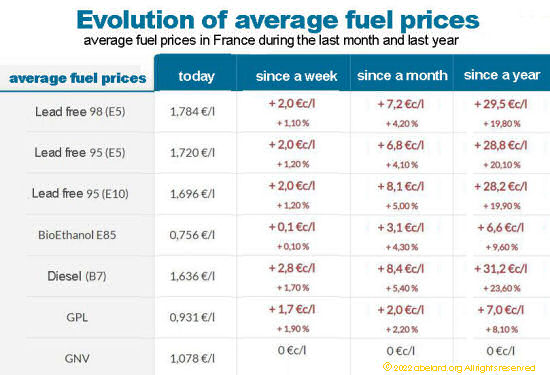
source : carbu.com
covid-19, oil markets, politics, and the economy
This exceptional rise in fuel prices is not unrelated to the health crisis. "Despite the rise in Omicron cases, European governments believe the time has come for an easing of restrictions, fueling hopes of a rise in oil demand," said analyst Tamas Varga, quoted by Reuters. Generalised confinements,with the consequent freezing of the economy, are no longer envisaged.
The price surge is also explained by the current tensions in Kazakhstan. These are pushing up oil prices to a degree, as investors fear future supply disruptions from the largest oil producer in Central Asia.
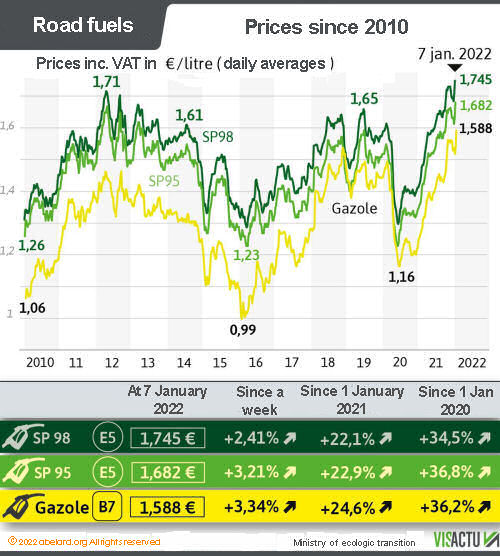
Fuel prices since 2020, VISACTU
Prices expected to rise further
In 2021, the price of a barrel of oil rose to more than 80 dollars, more than 70 euros. Global demand, and OPEC countries and others trying to keep production lower are both factors that lead to pump prices rising in the coming months. At the same time, if prices rise 'too high', consumers will avoid using their fossil fuel vehicles.
Of course, the ever increasing use of electric vehicles means the demand for fossil fuels will fall more and more. The conflicts between governments and companies wanting more revenue, while consumers look to ways to economise and the Earth forces a ginormous clean-up, makes for a see-saw of price increases and reductions.
1 January 2015 - dropping fuel prices increased by taxes
As crude oil prices fell in 2014, fuel prices went down 17.7% for gazole (diesel in English) and 14.9% for 95 octane petrol. Is this the real reason why the French government has jacked up the tax on fuels again, rather than the official line of reducing air pollution?
80% of French vehicles use diesel fuel, and being more efficient than petrol-fuelled cars, they use 20% less fuel. This makes rather hollow the claims that diesel is more polluting. (Of course, there are still a small number of older, highly polluting diesel vehicles about, but most prefer to trade those in for more efficient, and so less polluting, newer models.)
From the 1st of January 2015, all vehicle fuel prices will increase by 2.4 centimes per litre (including TVA), an increase being termed as carbon tax. In addition, gazole will increase by a further 2 centimes per litre, making the total increase for gazole 4.4 centimes per litre. It is said that the additional portion of increased tax is to compensate for the collapse of the ecotax or environmental tax on trucks.
The ecotax was to be charged on heavy goods vehicles [poids lourds - PL], the original plan being to register the movements of heavy goods vehicles on non-motorway roads, then send bills charged a per-kilometre road tax.
173 costly gantries with cameras had been erected to record the HGVs' movements, by detecting an obligatory black box installed in the lorry's cab. However, riots, road blocks and lorry go-slow demos [escargots - snails] on major roads during 2014 has forced the tax to be abandoned. Now the government is wary of upsetting commercial drivers further by targeting taxes solely at them.
 |
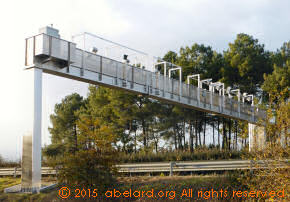 |
The government had been in a legal battle with the gantry constructors over cancelling their contract. This specified the constructors were to receive a portion of the revenue to be generated in payment for footing the construction bill. The conclusion of this battle is that the French government will be paying out 839 million € in all, 580-590 million € by February 2015, then 30 million € annually for 10 years. This agreement includes paying the salary for a year of the 220 white-collar employees made redundant, many of whom had taken out mortgages on the basis of an excellent, government-funded salary. However, this may not be the end of the story as far as the company concerned, Ecomouv, says their receipts would have been more like 2 billion € over 10 years.
Update, February, 2015: The final amount to be repaid is just under a billion euro, at 958 million euro. Another reason why fuel prices will not drop to their current natural level.
The ecology minister, Ségolène Royal (n° 3 in the government and ex-long term partner of unpopular President François Hollande) has proposed that these unsightly gantries now be used by the gendarmeries and customs (at further cost), rather than be dismantled at a suggested cost of between 7 to 13 million euro.
Work notes
Where to stay
Michelin red guide…maps hotels and much else |
















